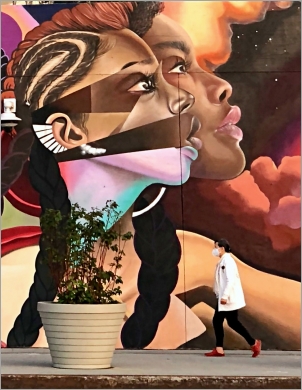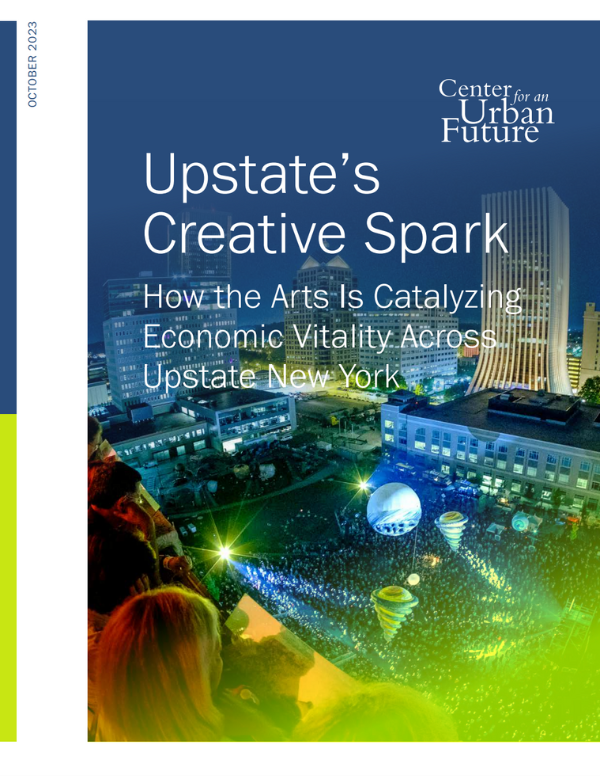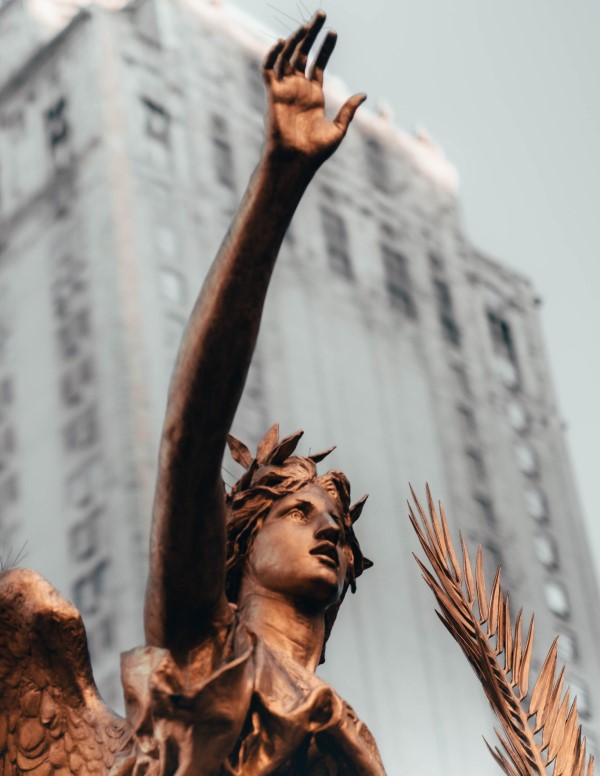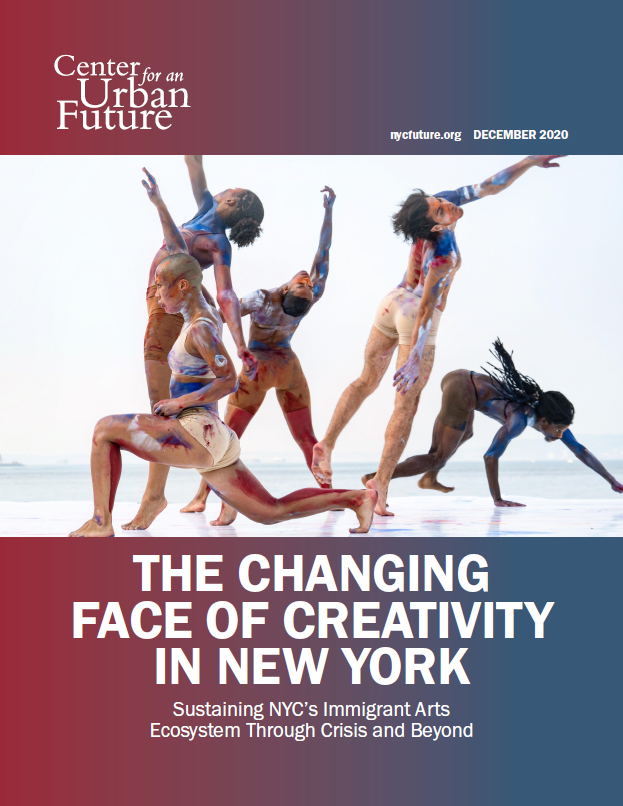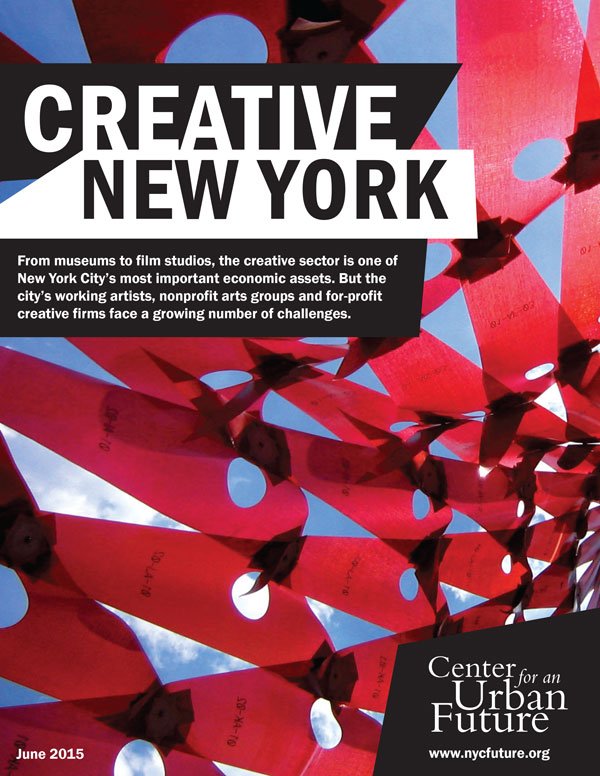No industry in New York City has gone unaffected by the COVID-19 pandemic, but few have been shaken like the arts and cultural sector. This analysis of new survey data finds a cumulative decline in income of nearly $1 billion ($924.6 million) among city-based arts organizations—a 36 percent plunge from the year prior to the pandemic. The city is home to just half the number of arts jobs that existed prior to the pandemic, wiping out more than $1.5 billion in wages.1 Three in four organizations have had to make budget cuts, resulting in thousands of layoffs, nearly a year’s worth of canceled programs, and the widespread loss of performance, rehearsal, and exhibition space.
This analysis—supported by the New York Community Trust—draws from data provided by Americans for the Arts, which surveyed 643 community-based arts organizations across all five boroughs on behalf of the city’s Department of Cultural Affairs (DCLA). Representing one of the largest surveys of the city's arts ecosystem to date since the start of the pandemic, the data offers fresh insights into a year of unprecedented loss for individual artists and arts organizations, including lengthy shutdowns, steep declines in revenue, slashed budgets, and sustained job losses.
After experiencing a near-total shutdown over one year ago, the arts organizations surveyed report employing far fewer people than before the pandemic hit. As a result of revenue shortfalls and prolonged closures, 45 percent of organizations have been forced to lay off or furlough staff. The toll has hit working and teaching artists especially hard: Among individual artists and creative workers formerly employed by arts organizations, 58 percent were still laid off or furloughed at the time of the survey—more than a year after lockdown.
While nearly every organization in the survey has suffered a toll, organizations that primarily serve communities of color and low-income communities have been disproportionately affected by the crisis. BIPOC-led organizations were more likely to report a severe financial impact from the pandemic, less likely to be confident in their long-term survival, and twice as likely to report that their entire staff was still laid off or furloughed. Fully 25 percent of organizations in lower-income zip codes reported losing access to their sole physical space during the pandemic, compared to under 12 percent of organizations located in other areas. In addition, smaller organizations were hit especially hard. The average small organization saw its operating income plummet 40 percent in FY 2020, compared to FY 2019—significantly more than mid-sized and large organizations’ respective 12 and 21 percent dips.2
Yet, even as arts groups encountered one roadblock to solvency after another, arts and cultural organizations proved immensely resilient and adaptable. While almost 3 percent of organizations surveyed have closed completely or don’t expect to return in 2021—a devastating loss for the city’s cultural life—the vast majority of organizations are planning a comeback. Since the pandemic began, 65 percent of surveyed organizations have started delivering virtual programming for the first time. And 45 percent of organizations strengthened an existing diversity, equity, and inclusion plan as a mass movement for racial justice swept the country.
Still, our analysis finds that much more is needed to help support the arts and cultural sector in the coming months. Although more than three-quarters of organizations feel confident in their survival, a strong and equitable recovery will require major new public and private support. Just one-third (34 percent) of organizations have a concrete plan to reopen, and an alarming 49 percent lost access to a physical space. Organizations report needing cash to fund a reopening plan, help rebuilding their audiences, support to establish new physical spaces and invest in safety upgrades, and assistance with marketing and promotions. And while survey respondents received a remarkable $497.8 million in total relief funding, that amount still falls $172.3 million (26 percent) short of making up for a net financial loss of over $670.1 million.
New York City faces a long road to economic recovery, made all the more challenging by the severe damage done by the pandemic to the city’s cultural ecosystem. Without the city’s uniquely vibrant and diverse cultural life, fewer businesses will reopen, fewer visitors will return, and the city will lose a defining feature of its identity as a global hub of creativity. As this analysis shows, the economic impact of the pandemic has been painful—especially so for many of the city’s smaller, neighborhood-based arts organizations and for working artists themselves.
At the same time, the city’s cultural life is proving remarkably resilient—and organizations of all sizes are poised for a major comeback. But city leaders, including the next mayor, will have to take further action to stabilize the city’s cultural ecosystem and strengthen it in the future. Policymakers will have to build a stronger safety net for arts and culture, lift barriers and administrative burdens around public funding, partner with community-based organizations and philanthropy to offer expanded technical assistance, advance long-term sustainability through greater support for affordable real estate, and direct every city agency—not just the Department of Cultural Affairs—to consider new ways that their core programs and activities can support and strengthen the arts.
Key findings include:
Many organizations were forced to shut down almost completely, cutting off their ability to bring in crucial revenues and income. The pandemic decimated ticket sales as organizations across the city closed their doors in an effort to keep staff and audiences safe. Almost every organization was affected, with 98 percent of organizations having to cancel in-person events. As a result, revenues and incomes declined precipitously, leaving the majority of organizations facing severe financial hardship.
- Judging the pandemic’s overall financial impact on a 1–5 scale, from “1–Not Severe at All” to “5–Extremely Severe,” nearly 46 percent of organizations reported a 4 or 5, while only 16 percent reported a 1 or 2.
- 84 percent of organizations saw a decrease in income/revenue, while 7 percent saw no change, and just 9 percent saw an increase.
- Among all organizations that stopped holding in-person events, just 15 percent have resumed any kind of in-person programming.
- The arts and cultural sector experienced a total attendance loss of 35,107,123. The median organization in the survey saw their audience shrink by 4,500. The largest organizations in the survey saw audiences decline by 5.5 million and 3 million, respectively.

At the same time that revenues are down, organizations have been saddled with unexpected pandemic-related expenses. Many arts and cultural organizations adopted a hybrid or fully virtual programming model in response to the crisis. That has brought on a raft of new costs, whether they needed to purchase technology for staff to conduct virtual dance instruction or buy PPE and cleaning supplies in order to hold in-person events.
- Over half (53 percent) of organizations said that they incurred unanticipated expenditures, such as purchases of new technology/equipment/supplies, enhanced cleaning protocols, or unexpected marketing expenses. In total, these 342 organizations faced over $100 million of unanticipated expenditures.
- 26 percent of organizations had to acquire a new loan or line of credit to obtain access to cash during the pandemic, which may impose financial strain in the future.
With budgets and revenues seriously depressed, arts organizations were forced to impose layoffs and furloughs that still persist. The impacts could be felt across every borough, but small organizations and organizations that primarily serve marginalized communities have particularly struggled, according to our analysis of survey responses. And because fewer relief resources have been made available to individual artists and creative workers compared to organizations, the pandemic has been uniquely devastating for these individual workers.
- 75 percent of organizations had to make cost-saving budget cuts, leading to widespread layoffs and furloughs. Across all surveyed organizations, 2,701 employees were laid off, 3,183 were furloughed, and only about 33 percent of employees had returned to work as of March 11th.
- Among organizations that reported pandemic-related layoffs or furloughs, 24 percent of organizations that primarily serve low-income communities of color said three quarters or more of their employees are still laid off or furloughed, compared to 15 percent of organizations that don’t primarily serve those communities.
- 39 percent of the 243 organizations that reported any layoffs or furloughs say that more than half of their total pre-pandemic employees are currently laid off or furloughed. 8 percent reported that all employees are still laid off or furloughed, while just 6 percent report no employees currently laid off or furloughed.
- Among artists and creative workers, things were worse: 15 percent of organizations report that all their artists or creative workers are currently laid off or furloughed. More than half (58 percent) of the artists and creative workers employed pre-pandemic are currently laid off or furloughed. In total, 6,093 artists and creative workers were laid off, while 7,306 were furloughed. Only 13 percent of all laid off or furloughed artists and creative workers had returned to their jobs as of March 11.
- Large organizations have bounced back much faster: among larger organizations that reported pandemic-related layoffs or furloughs, less than 1 percent report that all their staff remain laid off or furloughed, compared to more than 29 percent of small organizations. Fully 72 percent of large organizations have rehired most of their pre-pandemic staff, compared to just 24 percent of smaller organizations.
- While organizations in every borough experienced severe revenue declines, increases in unanticipated expenditures, and heavy employment impacts, Queens, Staten Island, and Manhattan saw the highest rates of employment impacts: nearly half (49 percent) of organizations in Queens froze salaries, 46 percent in Staten Island froze salaries, as did 35 percent in Manhattan.
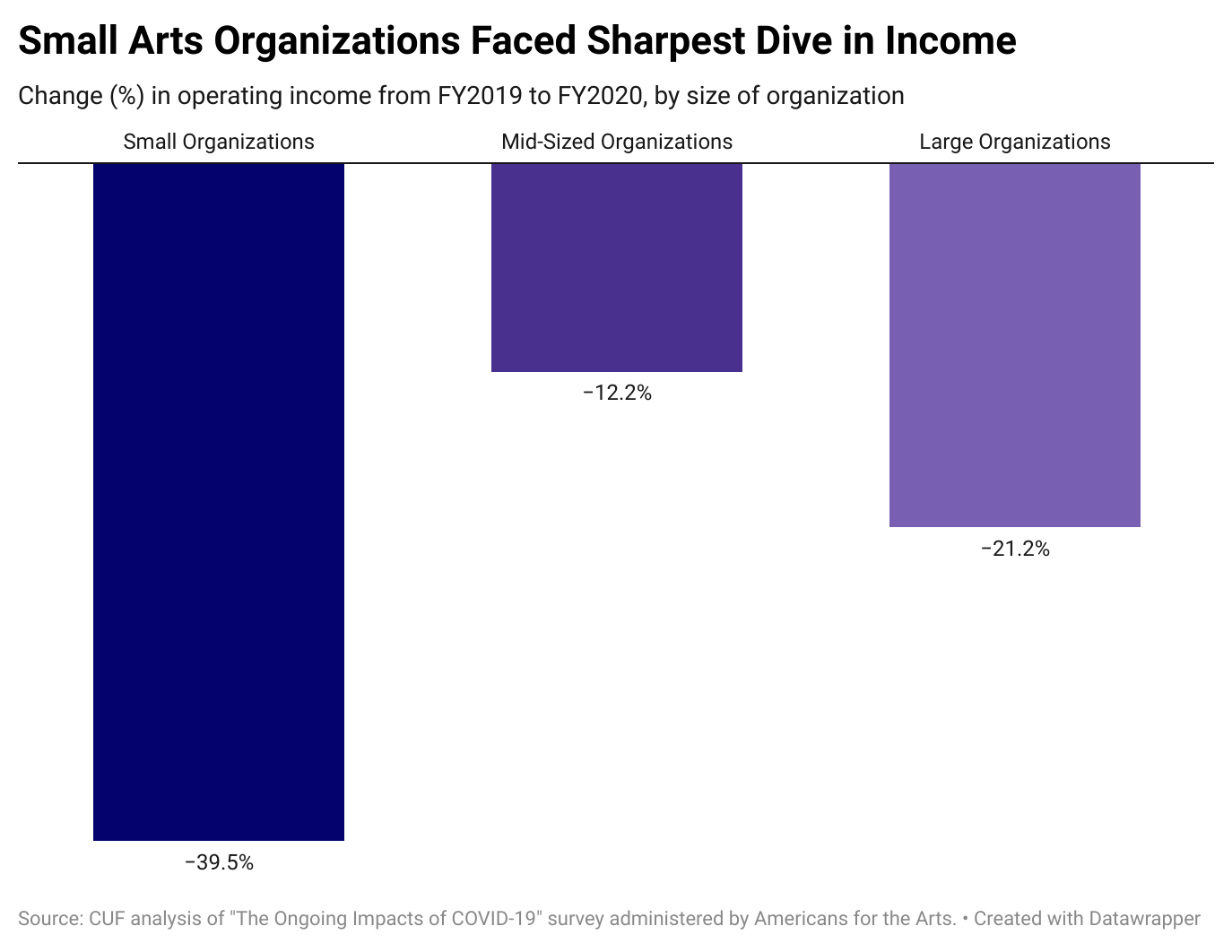
BIPOC-led organizations have been hit harder and are more likely to report needing cash to survive.3 While damage to the arts sector is severe and widespread, this survey makes clear that organizations led by Black, Indigenous, and/or people of color (BIPOC) are disproportionately impacted. They are more likely to report a severe overall financial impact and less likely to be confident in their ability to survive the pandemic and ensuing economic crisis. Layoffs and furloughs have further compounded recovery for BIPOC-led organizations, which are more likely to have reduced their staff and have struggled more to rehire staff compared to other organizations.
- 48 percent of BIPOC-led organizations rated the pandemic’s overall financial impact as a 4 or 5 out of 5 (5 being the most severe impact), compared to 44 percent of all other organizations.
- 70 percent of BIPOC-led organizations rated their confidence of survival as a 4 or 5 out of 5, less than the 78 percent of all other organizations that reported the same.
- 23 percent of BIPOC-led organizations furloughed artists or creative workers, a greater share than the 18 percent of other organizations, potentially indicating that they went to greater lengths to avoid layoffs.
- The average BIPOC-led organization that instituted any layoffs or furloughs has rehired 19 percent of the artists or creative workers who were furloughed, far less than the 30 percent of furloughed artists or creative workers rehired by the average non-BIPOC-led organization.
- One in eight BIPOC-led organizations that were forced to lay off or furlough staff report that their entire staff (100 percent of total employees) are currently still laid off or furloughed, nearly twice as high a rate as the 7 percent of non-BIPOC-led organizations that reported the same.
- 42 percent of BIPOC-led organizations that say they need resources to return to in-person programming list “cash/funding” as a needed resource, compared to just 35 percent of all other organizations.
Lower-resourced zip codes face an especially daunting recovery. Our study also digs deeper into geographical disparities by looking at the impacts of the crisis on a set of lower-resourced communities with a lower number of cultural assets, as defined by previous studies.4 For organizations in these neighborhoods—such as East New York, Hunts Point, and Far Rockaway—the impact of the crisis has been especially painful. Most organizations in these communities are BIPOC-led, and significantly more of them reported losing their spaces, needing cash assistance, and facing extremely severe financial impacts, compared to organizations in other zip codes.
- 72 percent of organizations located in lower-income zip codes that also lacked cultural resources report being BIPOC-led, compared to 33 percent of organizations outside of those areas.
- 25 percent of organizations in lower-income zip codes that also lacked cultural resources reported losing access to their sole physical space during the pandemic, compared to 12 percent of organizations not located in those areas.
- 56 percent of organizations in lower-income zip codes that also lacked cultural resources indicated their largest need was cash or funding to restart programming, compared to 36 percent of organizations not located in those areas.
- 26 percent of organizations in lower-income zip codes that also lacked cultural resources reported extremely severe financial impacts from the pandemic, versus 16 percent of organizations outside of these zip-codes.
Methodology
The survey from which this report derives its data was administered by Americans for the Arts on behalf of the New York City Department of Cultural Affairs. All responses were collected between February 16 and March 11, 2021. Surveys were distributed by DCLA, borough arts councils, and other partner organizations across all five boroughs. A breakdown of the 643 survey respondents is included in an appendix to this report. Responses were submitted by individual arts organizations through an online form administered by Americans for the Arts.
II. Despite historic challenges, NYC’s arts ecosystem proves strikingly resilient
Though most surveyed organizations had to suspend programming, the vast majority plan to come back and are already in the process of doing so. Organizations responded to the survey voluntarily, so it’s likely that some that closed did not respond. But a key takeaway, at this stage of the crisis, is that New York City’s arts ecosystem is resilient to previously unthinkable challenges.
Since last June, organizations report increasing optimism. This new data also allows us to see how organizations are faring in 2021 compared to a previous DCLA survey of 810 respondents in June 2020. While some of the hardest-hit organizations may have shuttered since the previous survey, we find some evidence that a large percentage of organizations have weathered the storm and feel confident in their future.
- In the 2020 survey, 11 percent of organizations indicated that they did not think they would survive the COVID-19 crisis. According to this new survey, just over 1 percent of organizations say they’re “not confident at all” in their survival, and another just 4 percent say their confidence of survival is a 2 (on a 1–5 scale from “1–Not Confident at all” to “5–Extremely Confident”).
While 2020 was an immense struggle, many organizations are moving towards reopening. There are significant outstanding needs among organizations that are looking to resume their in-person programming—the most basic and crucial being their audiences. But with vaccinations steadily underway, a good number of organizations are confident that they’ll be able to survive the crisis.
- Although virtually every organization had to shut down in-person programming, one in three organizations (34 percent) have already set a date to start again.
- The “resource” that the greatest proportion of organizations (42 percent) report needing to return to in-person programming is “audience/customers.”
- 15 percent of organizations temporarily stopped in-person events but are currently hosting them.
- Three-quarters of organizations indicated confidence in their organization’s survival, giving a rating of either 4 or 5 (on a 1–5 scale from “1–Not Confident at All” to “5–Extremely Confident”).
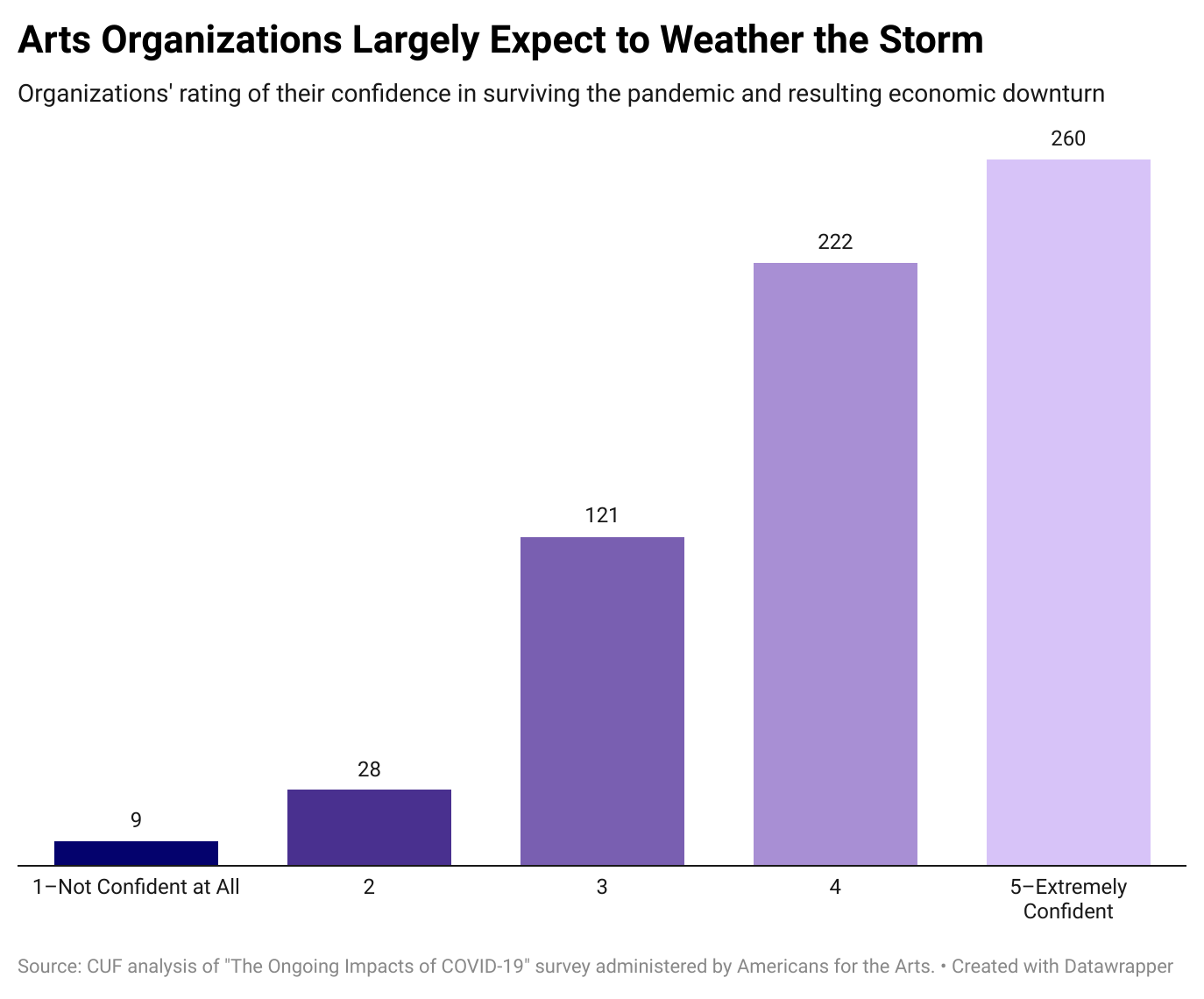
Many organizations have taken significant steps to expand virtual programming. Under huge amounts of pressure, arts and cultural organizations across the city continued creating and innovating. The survey responses showcase an immense effort on the part of organizations to devise and transition to online programming models. Some experienced fundamental shifts in how they approach their art. Many also stepped up efforts to reach some of the most vulnerable New Yorkers during the crisis.
- 68 percent of organizations report that they’ve innovated during the pandemic (e.g., by delivering products and services differently by transitioning to virtual programming)
- 65 percent of organizations have started delivering online programming for the first time, while another 26 percent have increased or enhanced their online programming and content.
- 38 percent of organizations have taken action to improve access to virtual programming for people with disabilities, 30 percent have taken action to improve virtual programming access for people who speak languages other than English, and 21 percent have taken action to improve virtual programming access for people with limited or no access to reliable internet.
Organizations’ focus on racial equity, justice, diversity, and inclusion has expanded. The past year saw the arts and cultural sector playing an important role in guiding their communities on matters of racial equity. Creative workers throughout the city have been pushing for greater diversity in their fields. And whether it’s meant launching new programs to center BIPOC voices or tackling equity concerns, arts organizations have shown a commitment to progress.
- More than one-third (35 percent) of organizations have launched a new program or curatorial effort to center BIPOC artists and communities.
- More than one-quarter (26 percent) of organizations have created new partnerships to foster or promote anti-racist programming, and more than half (54 percent) of organizations have dedicated space or time for staff to have conversations about racial equity.
- 17 percent of organizations currently say that issues of racial equity, justice, diversity, and inclusion are the primary focus of the organization (up from 14 percent at the start of 2020) while another 25 percent of organizations have a standalone focus on these issues in parallel with other efforts, compared to only 8 percent at the outset of 2020.
III. More support is needed for arts and cultural organizations to be able to come back strong
Despite the challenging road to recovery ahead, New York City’s arts and creative organizations are focused on coming back. But they’ll need more support to do so. Organizations across the five boroughs report that they need funding, audiences, and programming space to return to pre-pandemic programming, as 80 percent of organizations say virtual programming doesn’t pay for itself.
Funding is easily the most pressing need for organizations right now and as they recover in 2021. The federal government provided much-needed relief in the form of PPP loans and Pandemic Unemployment Assistance for independent contractors. Foundations and philanthropy also sprung to action and helped keep organizations afloat. As a result, many organizations received a sudden, welcome infusion of funding, but most are unlikely to receive that funding again.
- 37 percent of organizations report that they need cash or funding before they can return to in-person programming, the most of any resource needed after audience or customers.
- 54 percent of organizations say that technical assistance to support individual giving—helping groups develop strategies and campaigns to develop an individual donor base—is among the three most pressing technical assistance needs that would help with recovery and reopening, followed by strategic planning and board development.
- Among organizations that still need resources to return to in-person programming, 48 percent say it will take five to six months or longer to assemble the cash or funding necessary. Another 21 percent expect it to take three to four months, and 13 percent are unsure or not confident they’ll be able to access enough cash or funding at all.
- Among organizations that need resources to return in person, 38 percent say that federal dollars would accelerate their timeline for reopening. Another 45 percent say federal dollars would help achieve their timeline.
- 39 percent of organizations were forced to spend cash reserves or savings during the pandemic, 3 percent had to sell investments, 3 percent had to sell assets, 3 percent used endowment principal, 10 percent relied upon an existing loan or line of credit, and over 26 percent acquired a new loan or line of credit.
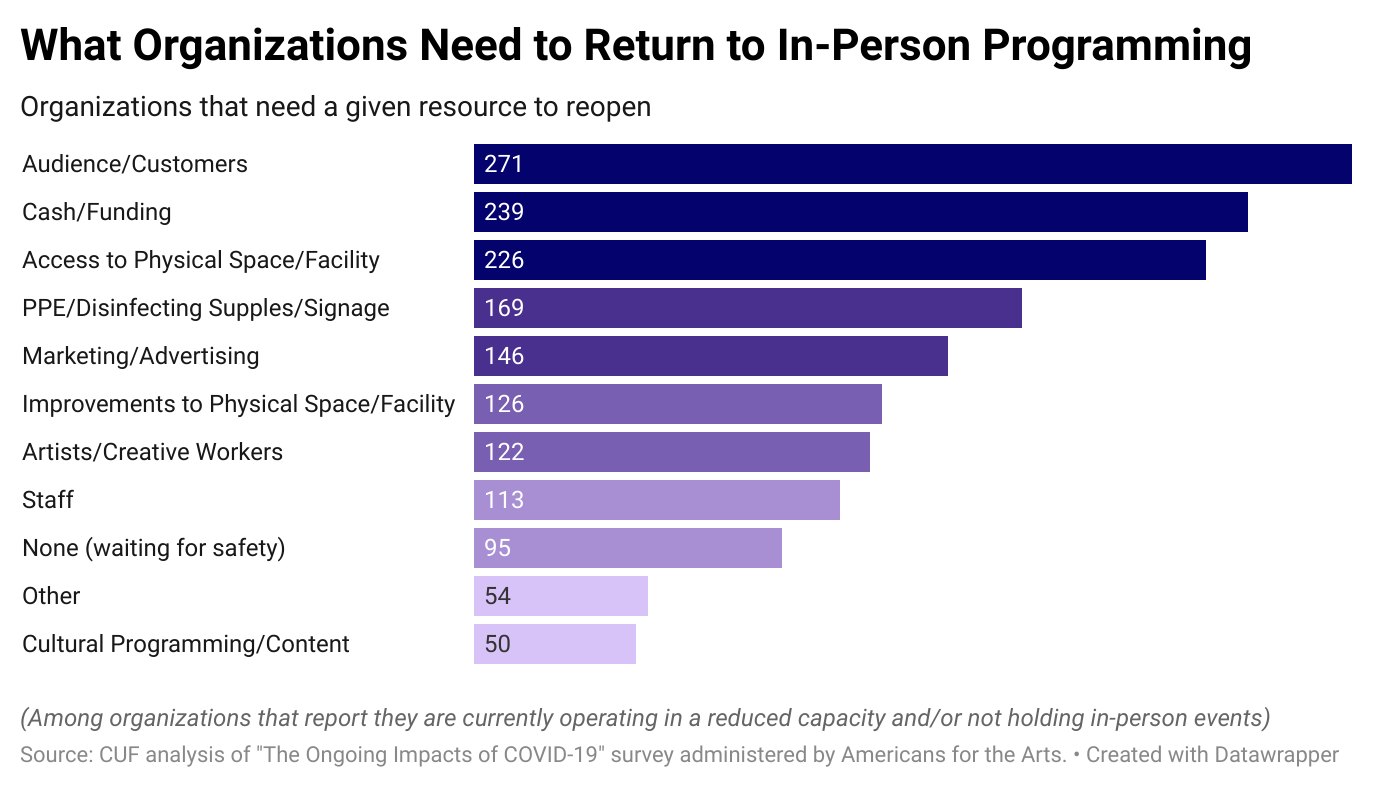
Many organizations lost access to their primary physical space in the pandemic, and finding new space is a key challenge. Affording rent on a performance or rehearsal space was hard enough before the pandemic. With their revenues and incomes down, many organizations had to give up their physical locations. Numerous survey respondents say that they will need a new space to fully reopen.
- 35 percent of organizations operating at a reduced capacity or not holding in-person events say they still need to get access to physical space before they can reopen in-person programming, the third-most-common need after audience or customers and cash or funding.
- 49 percent of organizations lost access to some or all physical programming space during the pandemic. Just 40 percent of organizations will return to the same physical programming spaces.
IV. Recommendations
City leaders—including the next mayor—will depend on the revival of the city’s shaken arts and cultural ecosystem to stage a strong and lasting economic recovery. But doing so will require a new level of support to address the damage accrued over the past year while building the infrastructure needed to sustain a stronger arts ecosystem for the long term. With a new level of support, New York City can tap into the full power of cultural organizations and working artists to breathe life into empty spaces, entice back millions of visitors, heal deeply scarred neighborhoods, and restore the city’s position as a global hub of creativity.
Sustain public funding for the arts and deploy a cultural safety net.
After more than a year of slashed revenues, budget cuts, and steep layoffs, cultural organizations and working artists face a long road to recovery. Far too few artists and cultural organizations were able to access sufficient cash relief—especially non-501(c)3 organizations and BIPOC-led organizations and artists—and the organizations that responded to this survey collectively report unmet losses of more than $170 million. The mayor and City Council should do more to make arts and cultural organizations whole. Mayor de Blasio deserves credit for committing $25 million to a City Artists Corps, but much more will be needed to put artists back to work, help cultural organizations secure new spaces and rehire staff, and address capacity-building needs to make organizations more resilient to future financial shocks. The city should commit to sustaining the budget of the Department of Cultural Affairs at or above the pre-pandemic level and launch new general operating support grants aimed at increasing financial stability in the arts, with a focus on small- and mid-sized arts organizations and those based in lower-income communities.
Launch a Culture Helpline and Arts Resource Centers in vacant storefronts.
Many arts organizations—especially smaller and BIPOC-led arts groups—report a significant need for technical assistance, including legal support; real estate services; accounting and financial management consulting; architectural and engineering services; and help navigating city, state, and federal grant and loan programs. To help meet these needs, the city should launch a staffed helpline for arts and cultural organizations—modeled on a similar program operated by London’s Culture at Risk office—and build a network of Arts Resource Centers based in vacant storefronts citywide. These storefront spaces would fill a critical role in reaching artists and arts groups that have been largely left out of relief grants, loans, or other support—including many immigrant-run organizations, groups without reliable Internet access, and youth-led groups—and create a feedback loop from local artists and arts groups to policymakers, philanthropy, and larger cultural organizations. Working with commercial landlords, local community-based organizations, artists, mutual aid groups, and volunteers, these storefront spaces would provide a one-stop-shop for local artists and cultural organizations to access technical support and free professional services—from grant writing to soundproofing—and offer artists a street-level space to showcase their work and exchange ideas with the surrounding community.
Direct every city agency to expand support for the arts.
To support a full revival of the city’s arts and culture sector, every government agency—not just the Department of Cultural Affairs—will need to take new steps to strengthen the arts. The next mayor should enlist every city agency in this effort, from the Parks Department and the Department of Transportation to the Department of Education and the Department of City Planning. Next steps should include sustained, multi-year funding for arts groups to program and maintain public spaces through the Open Culture program; new initiatives to connect artists with the thousands of arts spaces located in public schools; expanded programs to offer ticketed performances in public parks; new opportunities for artists to vend their works in public; and a major expansion of the Public Artist in Residence Program from just three city agencies to every agency by the end of 2022.
Pursue long-term affordability for artists and cultural organizations.
As this report shows, the pandemic has caused many organizations to lose their spaces and has left more than one-quarter of organizations located in lower-income communities without a physical home. To ensure a strong and equitable recovery from the pandemic, the city should seize the opportunity provided by a softer real estate market to greatly expand efforts aimed at securing long-term affordability for working artists and arts organizations. This effort could include down payment assistance to help organizations purchase buildings; city-backed master leases designed to offer artists and arts groups below-market rent and long-term stability; and a major new effort to develop 5,000 units of affordable artist live-work space.
V. Appendix
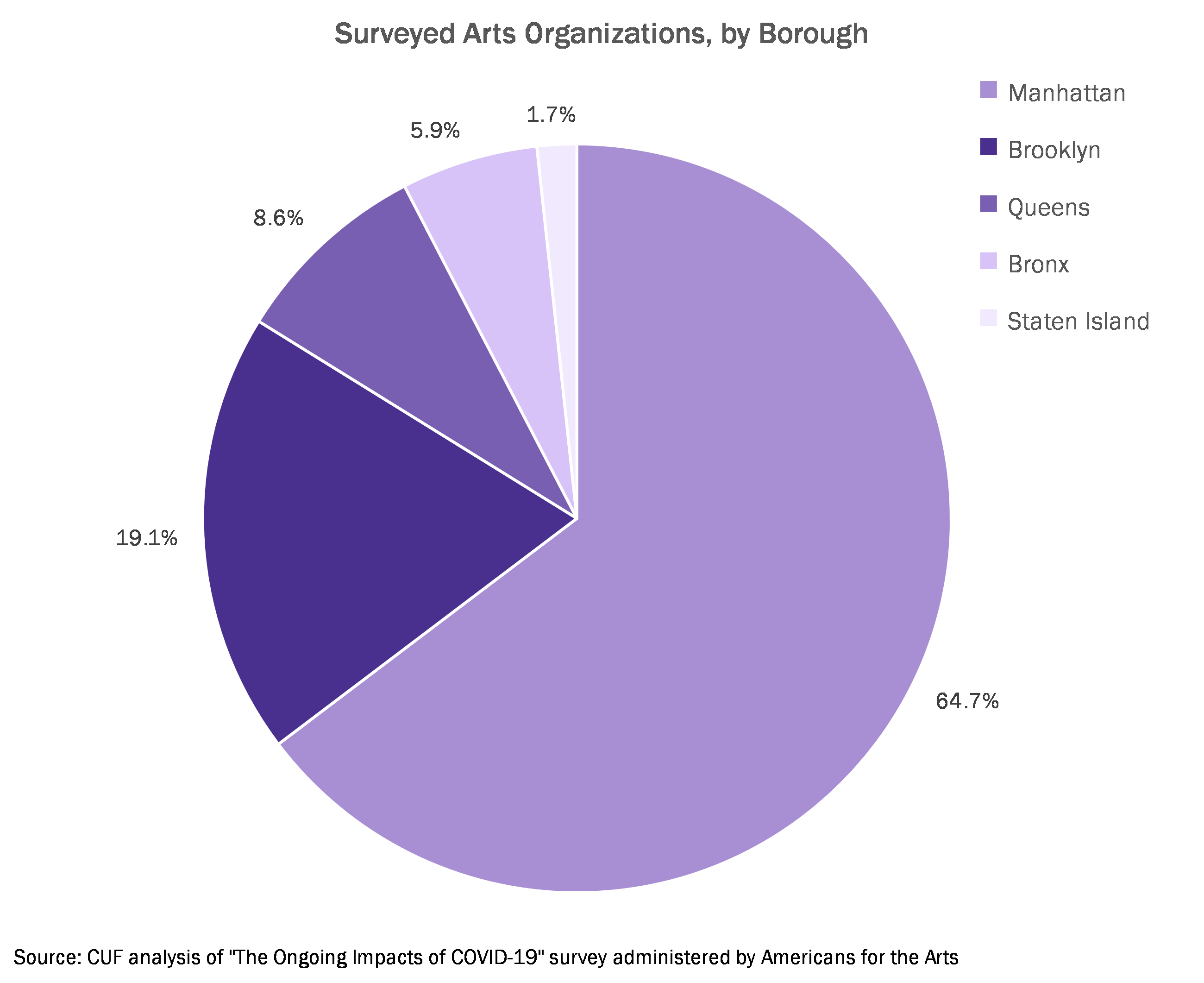
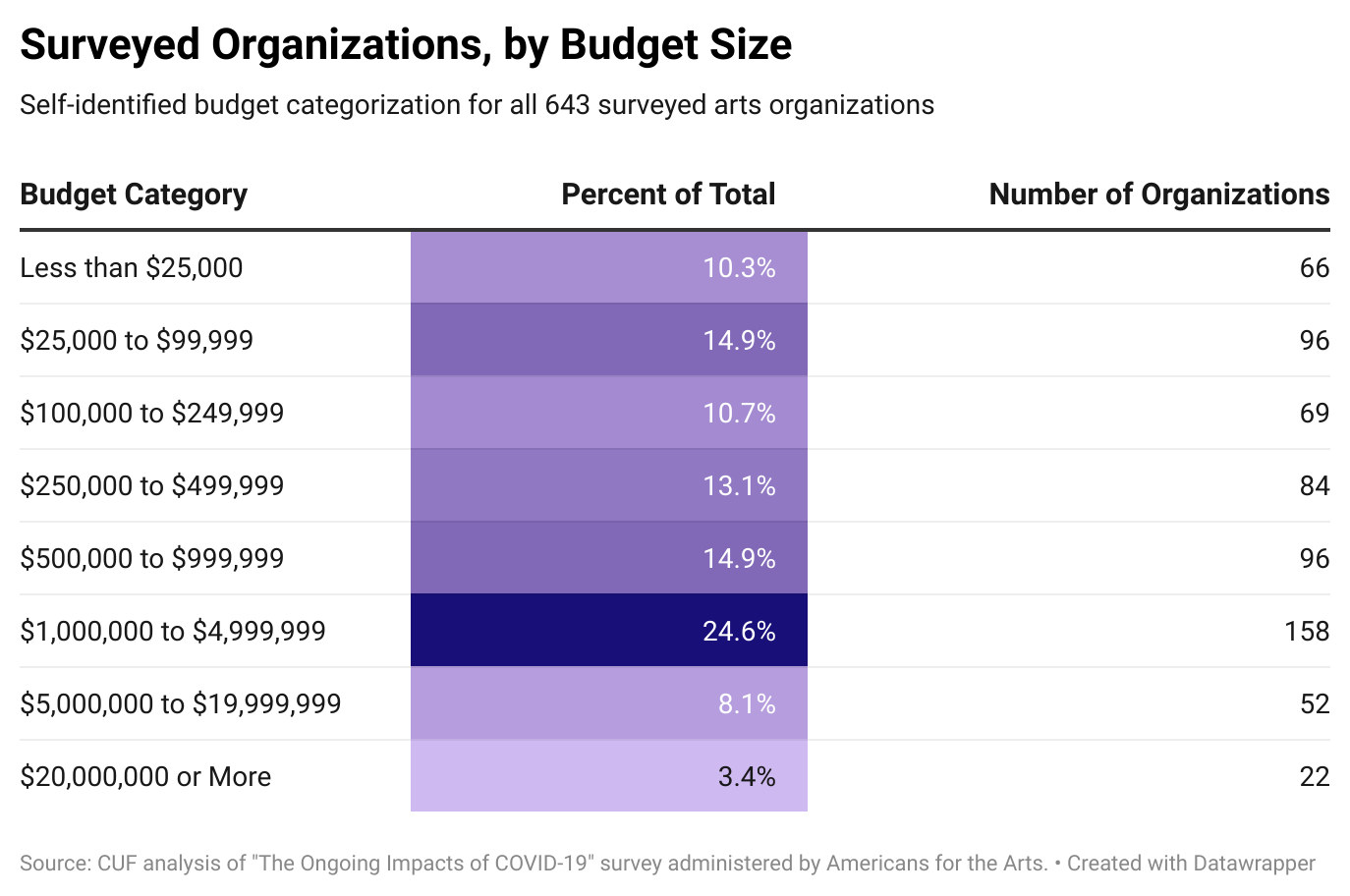
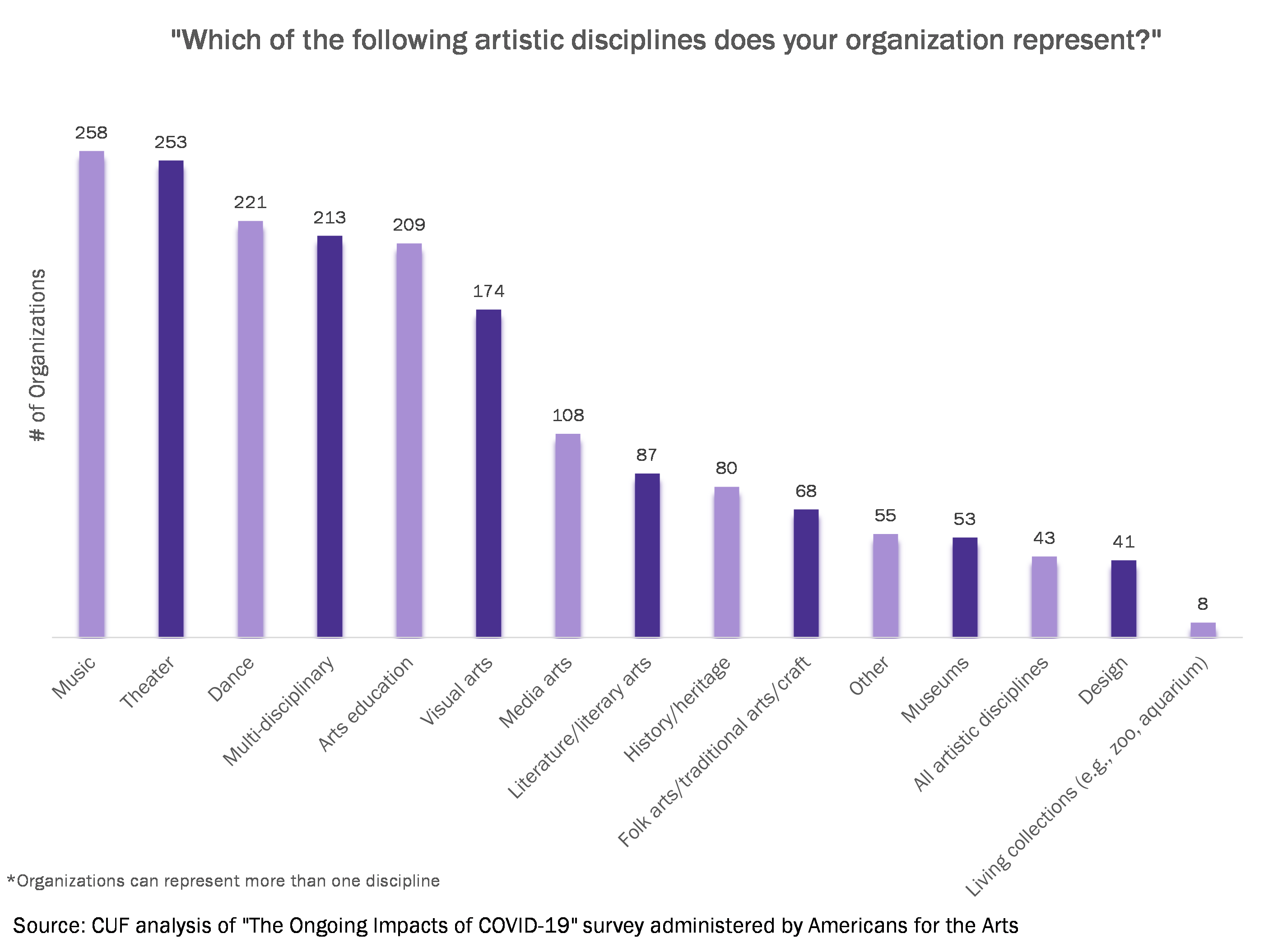
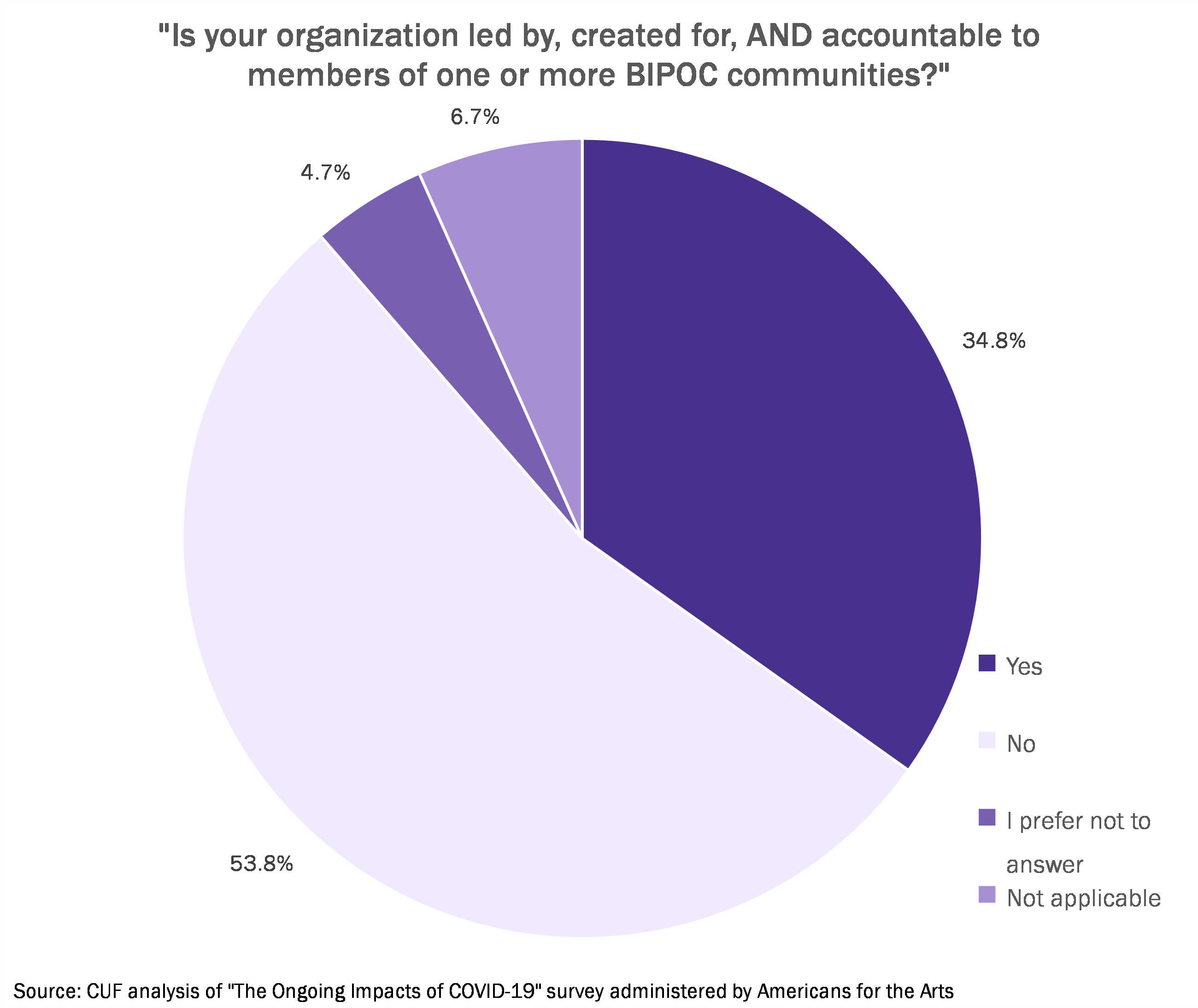
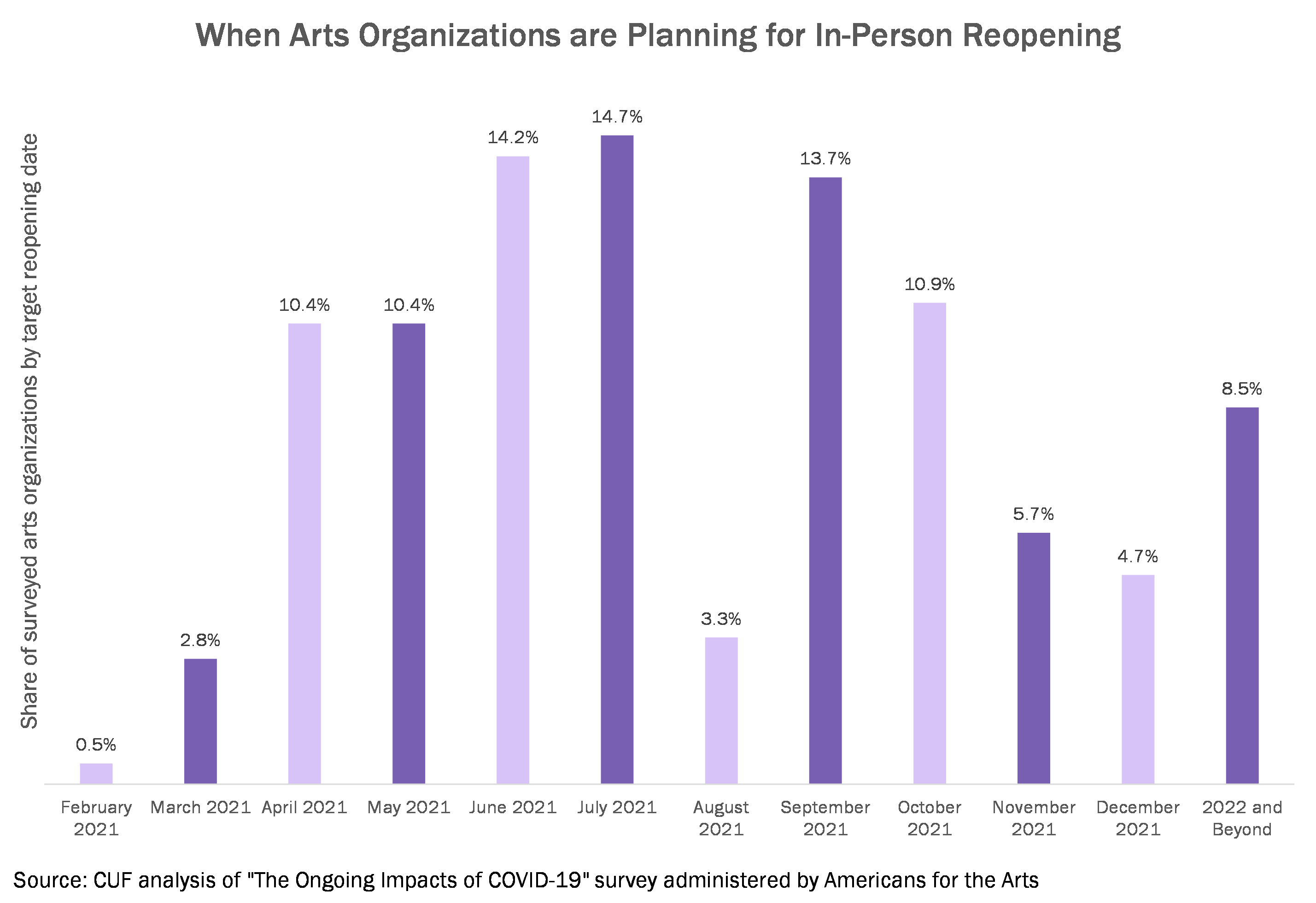
Endnotes
1. Center for an Urban Future analysis of data from the New York State Department of Labor. Employment in the three major industries comprising arts employment (performing arts, spectator sports, and related industries; promoters of performing arts, sports, and similar events; and museums, historical sites, and similar institutions) declined from 76,100 in March 2020 to 39,700 in March 2021, a 48 percent decline.
2. We defined small, mid-sized, and large organizations using the budget groupings in Q12 (“Which of the following budget categories includes your organization’s total projected income/revenue for its current fiscal year?”). Organizations that categorized reporting a budget of $249,999 or less were deemed “small,” organizations reporting a budget of $250,000–$999,999 were deemed “mid-sized,” and organizations reporting a budget of $1,000,000 were deemed “large.” By these definitions, 36 percent of organizations are labeled “small,” 28 percent are labelled “mid-sized,” and 36 percent are labeled “large.”
3. The survey asked organizations if they are led by, created for, and accountable to members of one or more BIPOC communities. The following data references organizations that answered “yes” to one of these queries. We refer to such organizations as “BIPOC-led.”
4. This analysis uses zip codes defined in a previous study as having a low concentration of cultural organizations and among the lowest incomes compared to the citywide median income. See https://repository.upenn.edu/cgi/viewcontent.cgi?article=1000&context=siap_culture_nyc.
